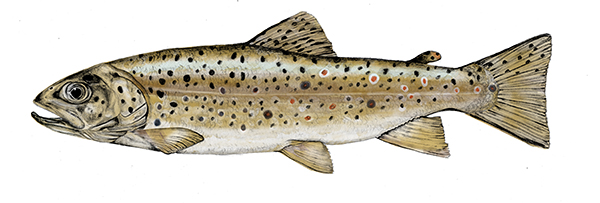Home → Fish & Wildlife → Fisheries → Species Information → Brown Trout
Brown Trout

Common Name: Brown Trout
Other Names: German Brown Trout, Brownie
Scientific Name: Salmo trutta
Origin: Introduced
Adult Size: Normal size is 14-20 inches and 1-2 pounds. Browns occasionally reach 10 pounds.
Identification: Usually coloration is light brown or tawny with pronounced black spots on the back, sides and head. Spots are often surrounded with reddish halo, along with reddish spots on the sides. Color is highly variable and browns are occasionally confused with landlocked salmon.
Diet: Brown trout are opportunistic feeders and their diet includes a variety of insects, fishes, crayfish, mollusks, and even small mammals.
Fishing tips: Brown and rainbow trout prefer cool water and are found in water temperatures between 55 and 68 degrees — a wider range than most other coldwater fish can handle.
Opportunistic and aggressive feeders, they may be found close to bottom or suspended off the bottom depending on where food is located, and are likely to attack a flashy lure, minnows, or worms.
In the spring and fall, brown and rainbow trout can be caught close to shore casting with dry flies, streamers, and bright spinners and spoons. Another successful method in spring time is still fishing with worms or minnows.
In the summer, trolling, casting, and still fishing are all popular and effective ways to catch this species.
Successful methods used while ice fishing include the use of traps or jigging in water that is relatively shallow (under 15 feet) with the target depth being close to or on the bottom. If you are fishing traps and getting a lot of hit-and-run activity, then try smaller minnows or other forms of bait like worms or salmon eggs. Jigging is typically far more effective than traps when targeting brown trout.
Interesting facts: Of all the sportfish in the state, brown trout are likely the most difficult to catch for Maine anglers. One characteristic that contributes to these low catch rates is that brown trout becoming increasingly nocturnal (active at night) during spring and even more so during the summer months.
Under favorable environmental conditions (e.g. available year-round forage, low competition/predation, suitable water quality) brown trout can live in the wild for 10 or more years. They are typically longer-lived than brook trout, rainbow trout, and landlocked salmon.
Management: Brown trout are native to Europe, North Africa, and western Asia, but they are now present on every continent (except Antarctica) due to their recreational angling appeal. Brown trout eggs were first shipped to the United States in 1883 and established in Maine fish hatcheries in 1885.
The Department’s stocking guidelines endorse brown trout stocking in waters that are unable to support high-quality fisheries for Maine’s native salmonids, namely brook trout and landlocked salmon. Typically, these are mesotrophic waters characterized by marginal summer water quality (i.e. limited volume of cool, oxygenated water), high levels of competition and predation, reduced forage availability, and inadequate spawning and nursery habitat. While these guidelines ensure protection to our native trout and salmon, they limit the number of quality waters where brown trout are stocked.
In 2020, MDIFW completed a multi-year field and hatchery study to evaluate the performance of three strains of brown trout – New Gloucester, Sandwich River, and Seeforellen. The Seeforellen strain outperformed the other two in both the field and hatchery components of the study. Specifically, in the field evaluation, the Seeforellen strain was the clear-cut winner in terms of genetic integrity, post-stocking growth and survival, and angler harvest. As a result, the Seeforellen was selected as the lone brown trout strain to be used in the MDIFW hatchery system moving forward.
The physical appearance of the Seeforellen (silver with dark spots) looks much different than the strain used almost exclusively over the past several decades in Maine waters – the New Gloucester (brown/yellow with black, red, and brown spotting). Understandably, recent brown trout stockings have caused confusion, as the Seeforellen strain looks very much like a landlocked salmon. While there are a few ways to physically differentiate the two (e.g. vomerine teeth arrangement, caudal fin appearance, size of adipose, fin clip presence/absence, etc.) the best way to tell which species you’ve caught might just be to peruse the state’s stocking report.